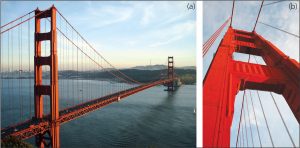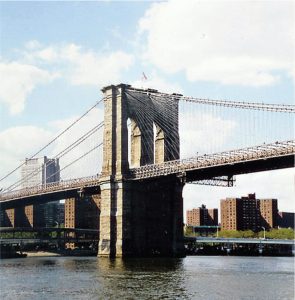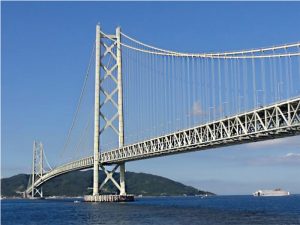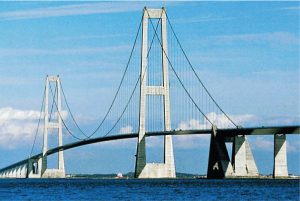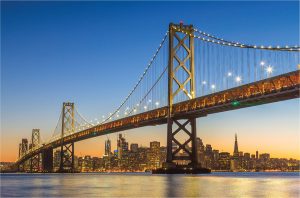To the engineers and builders of the amazing, elegant, and powerful structures commonly known as Great Bridges.
Remarkable, Signature or Great Bridges?
Mankind has been building bridges since the time of early civilizations. Today, bridges are all around us – they provide easier, faster, and safer connections between two points. Bridges have evolved from merely utilitarian structures to become symbols of cities, countries, and human progress. Iconic bridge structures embody engineers’ eternal aspiration to greater achievement – longer and taller, stronger and faster. We all admire bridges that span gracefully over a deep ravine, canyon, large river or bay, and rightfully consider them high technical achievements. However, very few of these bridges have acquired the prestigious title of “Great Bridges.” It may be interesting to find out what makes a Great Bridge.
A Great Bridge is one that can be distinguished from others by something unique or exceptional – longer span, singular beauty, appeal to the general public. Throughout history, people have admired and prized remarkable buildings and structures. As early as about 150 BC, the Seven Wonders of the World defined a grouping of the most renowned constructions of the time. While there were some bridges built as early as 850 BC (like the Caravan Bridge at Smyrna in Turkey, still in use), no bridge was included in the Seven Wonders. With the development of civilization and correspondingly higher standards of construction, many other buildings and structures were in their turn named as an “Eighth Wonder of the World” in recognition of their high achievement. Among others, these have included the Brooklyn Bridge in 1883 and the Golden Gate Bridge in 1937. We also often see the term “great” applied to a new architectural or structural project. However, mere months later, few of these achievements are still identified as exceptionally great.
One way to estimate the development of a society is by considering the level of its structural achievement. The great architectural and structural achievements at different periods of human history are a product of the building knowledge and available construction technology at the time of their creation. There are enormous differences between the construction possibilities in Roman times and those in the last six to seven decades. Therefore, when we review the development of bridges, it would be fair to consider their achievements in relation to the technical level at the period of their creation.
Historical Great Bridges
Based on the historical development of construction, remarkable bridges can be subdivided into ancient, medieval, industrial revolution, and modern Great Bridges. Ancient greats include those bridges serving as aqueducts or bridges for military conquests. Examples include the Pont du Gard aqueduct (40–60 AD), a three tiered stone bridge, Caesar’s bridges over the Rhine river during his conquest of Gaul (50s BC), and Trajan’s Bridge (104 AD) and Constantine’s Bridge (328 AD), both over the Danube river.
Medieval and Renaissance bridges were often stone bridges serving as crossings within cities, and including buildings and shops on top of the bridge structure. Examples include the Ponte Vecchio in Florence (1564), the Rialto Bridge in Venice (1591) and the “Old” London Bridge (1209).
The bridges of the Industrial Revolution were some of the first long span bridges. These heroic era bridges include: the Menai Strait Suspension Bridge (1826, 577-foot span); the Britannia Bridge (1850, two 459-foot spans, a wrought continuous box girder bridge), also over the Menai Strait; the Clifton Suspension Bridge (1864, 702-foot span) over the Avon Gorge; the Garabit Viaduct (1884, 541-foot span) by Gustave Eiffel; and the Firth of Forth Bridge (1890, two 1,709-foot spans).
High-Level Achievements in Bridges
Several bridges are notable for their high level of achievement, but still don’t qualify individually as a great bridge. These include the Verrazano Narrows Bridge, for its span, and the Bosphorus Bridge I, built between two continents. Several cable-stayed bridges should be noted for their long spans, including the Normandy, Sutong, Stonecutters, Maracaibo Bay, Rion Antirion, Millau Viaduct, Sunniberg, and Russky Island Bridges. This structural system, in just 50 years, reached free-spans exceeding 3,280 feet. It is still too soon to tell if any of these bridges will be added to the group of Great Bridges.
“Signature” Bridges
Many cities have commissioned eminent engineers to design new “signature” bridges, intended to become symbols of the adjacent city or area. The most prominent bridges identified as “signature” bridges include: Erasmus Bridge, Rotterdam, 1996, a cable-stayed bridge, main span 932 feet; Millennium Bridge, London, 2002, a cable-stayed pedestrian bridge, main span 472 feet; and the Sundial Bridge, CA, 2004, a pedestrian cable-stayed bridge, main span 492 feet. Calatrava’s Alamillo Bridge (Seville, Spain, 1992, 656-foot [200 meters] main span) is a beautiful, yet controversial bridge design due to its deviation from basic cable-stayed systems, resulting in high inefficiency. The notable omission of back span cable-stays creates a dramatic view and contributes to the attractiveness of the bridge, but such a concept has been discouraged for any bridge not built as a monument.
The self-anchored suspension part of the East span of the SF-Oakland Bay Bridge (2016, 1,263 feet) became an example for an inefficient design concept. The cost, construction material quantities, and building schedule were 7 to 8 times greater than for bridges with similar span but with other structural systems.
All these bridges resulted in very costly projects and proved inefficient in materials and construction time. These “signature” bridges are closer to structural extravagance than to Great Bridges. While these “signature” bridges have interesting, even attractive looking structures and often became symbolic of their locations, none of these exceptional pre-planned structures has gained recognition as a Great Bridge.
Record Long-Spans?
Every new bridge that establishes a record for longest span may be considered a Great Bridge in some way. Breaking the long-span record is a move into new territory; it requires an extremely talented, well-prepared team of designers and builders. Such achievement is only possible by using the highest available level of bridge engineering, some recent innovations and experience gained from previous complicated structures, and challenges and competitions between engineers, architects, companies, and nations. Several sources list the longest bridge spans (absolute or per structural system like suspension, arch, continuous girders). This provides for simple differentiation, as the span length is the only value to be considered. However, just a few of these bridges, holders of record-span at the time of their completion, have gained the prestigious title of a Great Bridge and have been able to preserve the title. Therefore, merely breaking the record for the longest span is not sufficient in and of itself; entering into this prestigious club depends on the long-lasting perception of the public at large.
Modern Great Bridges
The fast development of structural analysis and construction technologies in the 20th century provided a significant development and improvement in bridge construction, resulting in the creation of the modern Great Bridges. Some of their forerunners among late-19th-century bridges are also included in this group.
Golden Gate Bridge, San Francisco, California, USA, 1937, spans the Golden Gate Strait, the entrance from the Pacific Ocean to San Francisco Bay. The bridge’s central span is 4,200 feet (1,280 meters) and was the longest span in the world until 1964 (Figures 1a and b). The bridge created a much-needed link between San Francisco and the Northern Bay Area. The Golden Gate Bridge was designed by chief engineer Joseph Strauss, who assembled a team of experienced bridge engineers. Architect Irving Morrow worked closely with the engineers, making the decisive aesthetical improvements, providing the Art Deco style of the bridge towers and the “International Orange” color, thus contributing to it recognizable image and fame. The combination of a dramatic site and the elegant, powerful structure is essential for considering it one of the greatest bridges ever built. The changing day and night visual conditions, from bright sunlight and shade to an almost opaque layer of fog, provide countless view variations for the bridge and its elements.
Brooklyn Bridge, New York, USA, 1883, spans the East River, connecting Manhattan with Brooklyn. The Brooklyn Bridge is a hybrid of a suspension and cable-stayed structure, the first bridge using steel wire cables. It was envisioned and designed by John Roebling. The construction was complicated, with a much longer central span, 1,594 feet (486 meters), than any other bridge at that time. From its opening day, the bridge became one of the landmarks of New York; it is still one of the city’s major attractions (Figure 2). The link between Manhattan and Brooklyn was essential for the development of Brooklyn. The beautiful bridge, with the Manhattan skyline behind it, is a favorite choice for photography due to the pedestrian access to the bridge deck, from the ground on both sides near the structure, and from vessels on the river.
Tower Bridge, London, UK, was built from 1886 until 1894. The bridge is a combination of a suspension and a bascule system over the River Thames, with the largest span at 270 feet (82 meters). It is located near the Tower of London, which gave the bridge its name, today an equally recognizable symbol of London. The structure was designed by Sir Horace Jones and supervised by Sir John Wolfe-Barry. It was a great relief for most Londoners, providing a connection between the two sides of the Thames, as the then-existing London Bridge was far insufficient for the demand. The bridge contains two bascules which can be raised for river traffic and pedestrian walkways at 141 feet above the river, a smart design approach that permits pedestrians to use the bridge even when the bascules are raised.
Sydney Harbor Bridge, Sydney, Australia, 1932, is a steel through-arch bridge crossing Sydney Harbor with a main span of 1,650 feet (503 meters). The bridge carries a primary route between the residential North Shore and the central business district of the city. It was designed and built by the British firm Dorman Long and Co. The beautiful view of the bridge with the harbor and the Sydney Opera House completes the familiar, breathtaking skyline of the city. It is a symbol of Sydney and Australia. The arch was constructed first and served as a support for the superstructure.
Akashi-Kaikyō Bridge, Japan, 1998, was designed by Honshu-Shikoku Bridge Authority with a span 6,532 feet (1,991 meters). The bridge is a suspension steel structure crossing the Akashi Strait and connecting the city of Kobe on the Japanese island of Honshu to Iwaya on Awaji Island. Since its completion, the bridge holds the world record for longest bridge span (Figure 3). According to some experts, this bridge is the top achievement in the classic suspension bridge system with stiffening trusses largely used and developed in Northern America. The bridge was designed with a two-hinged stiffening girder system, allowing the structure to withstand winds of 178 mph (286 km per hour), earthquakes measuring up to magnitude 8.5, and strong sea currents. The bridge also contains tuned mass dampers that are designed to operate at the resonance frequency of the bridge to reduce seismic and wind forces. Visitors can walk under the bridge deck at the level of lower truss bracing and can go up an elevator to the top of one of the bridge towers.
Great Belt East Bridge, Denmark, 1998, has a main span of 5,328 feet (1,624 meters). The structure was designed by COWI, Klaus Ostenfeld et. al. The central suspension span is the longest span in Europe and currently the third-longest bridge span in the world (Figure 4). The bridge is part of the Great Belt Fixed Link that runs between the islands of Zealand and Funen, and replaced the ferry service that had been the primary transportation means in the past. The link has reduced travel times significantly; previously taking about an hour by ferry, the Great Belt can now be crossed in about ten minutes. The construction of the link and the previously completed Øresund Bridge enabled driving from mainland Europe to Scandinavia.
George Washington Bridge, NYC, New York, USA, 1931. The chief engineer of the bridge was Othmar Ammann, with Cass Gilbert as architect. With a span of 3,500 feet (1,067 meters), this bridge held the longest span record until 1937, at nearly double the span of the previous record holder.
The George Washington Bridge is a double-decked suspension bridge spanning the Hudson River between the Washington Heights neighborhood in the borough of Manhattan in New York City and New Jersey. As of 2015, the George Washington Bridge carries over 106 million vehicles per year, making it the world’s busiest motor vehicle bridge. Originally, the steel towers of the bridge were designed to be encased in concrete and granite. However, the towers were left as exposed steel to reduce costs. These steel towers, with their distinctive crisscrossed bracing, have become one of the bridge’s most identifiable characteristics. The world renowned architect Le Corbusier said of the exposed steel structure: “The George Washington Bridge over the Hudson is the most beautiful bridge in the world. Made of cables and steel beams, it gleams in the sky like a reversed arch.”
San Francisco-Oakland 1936 Bay Bridge, San Francisco, USA. The San Francisco-Oakland Bay Bridge connects San Francisco and Oakland. The bridge is actually a combination of several structures with different systems. Its main part is 10,302 feet (3,140 meters) in length. The West crossing from San Francisco to Yerba Buena Island (YBI) is a twin suspension bridge with central spans of 2,310 feet (704 meters) (Figure 5). The bridge was designed by Ralph Modjeski, Charles Purcell, et al. and built by the American Bridge Company.
At the time of completion, the bridge was the longest bridge in the world – 8.5 miles including approaches. It featured the second longest suspension span at 2,310 feet (704 meters), the third longest cantilever truss span at 1,401 feet, the deepest pier foundation (243 feet below the water surface at low tide), and the largest bored tunnel. The West crossing was the only major bridge with two consecutive suspension spans. The bridge, with its three principal segments, is listed as “One of the largest and most important historic bridges in the country.” President Herbert Hoover called this project “The greatest bridge yet erected.” It is not by chance that the designers of the Akashi-Kaikyo Bridge used the same type of main towers as the Bay Bridge.
Humber Estuary Bridge, East Yorkshire, UK, 1981, was developed by Freeman Fox & Partners. With its central span of 4,626 feet (1,410 meters), this bridge is a suspension steel bridge with towers consisting of a pair of hollow vertical concrete columns, each 510 feet (155 meters) tall. The bridge is designed to accommodate constant motion due to winds of 80 mph (129 km/h). The bridge held the record for the world’s longest single-span suspension bridge for 16 years, from its completion in July 1981 until the opening of the Akashi-Kaikyo Bridge. With the Humber Bridge, Freeman Fox & Partners developed their previous design for the Severn Bridge and Bosphorus I; these structures represent the “new modern type of suspension bridges” with shallower aerodynamic (aerofoil) deck and inclined suspenders. While these bridges are more efficient than the earlier American suspension bridges with steel stiffener trusses, they needed strengthening to accommodate increased traffic loads.
Conclusions
What makes a Great Bridge? A bridge that:
- Is an exceptionally designed and built structure;
- Is built in locations where the bridge was a longtime dream;
- Has to surpass previous records or excels over other structures;
- Is attractive, elegant, simple, slender, with a feel of robustness;
- Fits harmoniously within and complements its environment;
- Is easily accessible;
- Is accepted as an engineering and architectural achievement;
- Is highly recognized and celebrated by the community; and
- Withstands the test of time.
Even when all the requirements are met, the result can be just one more perfectly designed and built structure, but still not recognized as a Great Bridge. It should be understood that there is no recipe for designing and building a Great Bridge; the identification as a Great Bridge is a public recognition. They come into being by a fortunate combination of outstanding qualities of structural design in relation to their natural settings and superior construction achievements.▪
References
Billington, D. The Tower and the Bridge. Basic Books, Inc, New York, 1983
Leonhardt, F. The Significance of Aesthetics in Structures, SEI, 2/1996
Virlogeux, M. Structural and Architectural Design of Bridges, SEI 2/1996
McCullough, D. The Great Bridge. The Epic Story of the Building of the Brooklyn Bridge. Simon & Schuster, New York, 1972
Menn, C. The Place of Aesthetics in Bridge Design, SEI 2/ 1996
Mladjov, R. Long Span Bridges and the Art of American Bridge Engineering, SEAOC Convention, 2009
Starr, K. Golden Gate, the Life and Time of America’s Greatest Bridge, Bloomsbury Press, New York, 2010

